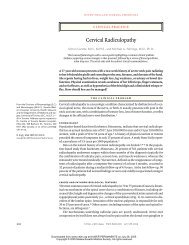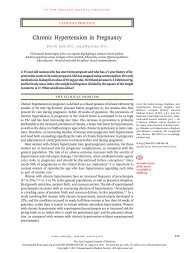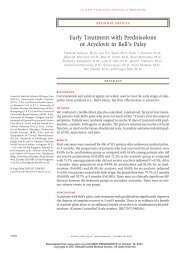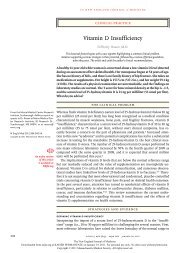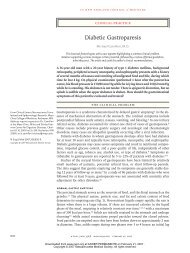Hypoparathyroidism - Q-Notes for Adult Medicine
Hypoparathyroidism - Q-Notes for Adult Medicine
Hypoparathyroidism - Q-Notes for Adult Medicine
Create successful ePaper yourself
Turn your PDF publications into a flip-book with our unique Google optimized e-Paper software.
The new england journal of medicine<br />
Table 2. Genetic Syndromes and Other Inherited Forms of <strong>Hypoparathyroidism</strong>.*<br />
Disorder<br />
Familial hypocalcemia<br />
with hypercalciuria†<br />
Familial isolated<br />
hypoparathyroidism<br />
X-linked hypoparathyroidism<br />
Responsible<br />
Locus or<br />
Gene Inheritance Pathogenic Mechanism Comments Reference<br />
3q13,CaSR Autosomal<br />
dominant<br />
11p15, preproPTH<br />
11p15, preproPTH<br />
6p23-p24;<br />
GCMB or<br />
GCM2<br />
APS-1‡ 21q22.3<br />
AIRE<br />
Autosomal<br />
recessive<br />
Autosomal<br />
dominant<br />
Autosomal<br />
recessive<br />
Xq26-27 X-linked<br />
recessive<br />
Autosomal<br />
recessive<br />
Heterozygous gain-of-function mutations in the<br />
CaSR that cause generally mild hypocalcemia<br />
and hypomagnesemia and hypercalciuria; mutant<br />
receptors cause a left-shifted set point <strong>for</strong><br />
PTH secretion, defined as the extracellular calcium<br />
level required <strong>for</strong> half-maximal suppression<br />
of secretion; the altered set point causes<br />
inappropriately normal or low PTH levels even<br />
at low serum calcium levels<br />
Mutations in the signal peptide, disrupting PTH<br />
secretion, or in a donor-splice site of the PTH<br />
gene, leading to skipping of PTH exon 2, which<br />
contains the initiation codon and signal peptide<br />
Point mutation in the signal sequence of pre-proPTH<br />
that prevents processing and translocation of<br />
PTH across endoplasmic reticulum and membrane<br />
<strong>for</strong> exocytosis<br />
Large deletion of GCMB with loss-of-function or<br />
point mutations in the DNA-binding domain of<br />
GCMB, abolishing its transactivation capacity<br />
Deletion and insertion involving genetic material<br />
from chromosomes 2p25.3 and Xq27.1, causing<br />
a position effect on possible regulatory elements<br />
controlling SOX3 transcription<br />
Loss-of-function mutations in AIRE, a zinc-finger<br />
transcription factor present in thymus and<br />
lymph nodes and critical <strong>for</strong> mediating central<br />
tolerance by the thymus; NALP5, an intracellular<br />
signaling molecule strongly expressed in<br />
the parathyroid, may be a specific parathyroid<br />
autoantigen in patients with APS-1; antibodies<br />
to NALP5 were identified in 49% of patients<br />
with APS-1 and hypoparathyroidism<br />
Phenotype caused by >40 mutations, mainly in extracellular<br />
and transmembrane domains of CaSR; Bartter’s<br />
syndrome (salt wasting, hypokalemia, metabolic alkalosis,<br />
elevated renin and aldosterone levels) subtype<br />
V also described in a subgroup of patients; constitutive<br />
CaSR activation described in two patients with<br />
acquired antibodies that activate the CaSR along with<br />
other autoimmune conditions<br />
Homozygous mutations in the pre-proPTH gene cause<br />
very low or undetectable levels of PTH and symptomatic<br />
hypocalcemia<br />
Mutant PTH is trapped within the endoplasmic reticulum<br />
inside cells; resulting stress in the endoplasmic<br />
reticulum is thought to predispose cells to undergo<br />
apoptosis<br />
GCMB is highly expressed in parathyroid tissue and<br />
controls embryologic development of parathyroid<br />
glands<br />
Parathyroid agenesis; transcription factor SOX3 is<br />
thought to be expressed in the developing parathyroid<br />
glands<br />
Cases are concentrated in Fin nish, Iranian Jewish, and<br />
Sardinian populations with >58 known mutations<br />
causing variable clinical presentations; classic triad<br />
is mucocutaneous candidiasis, adrenal insufficiency,<br />
and hypoparathyroidism (any two of these conditions<br />
are sufficient to establish the diagnosis); other features<br />
include hypogonadism, type 1 diabetes mellitus,<br />
hypothyroidism, vitiligo, alopecia, keratoconjunctivitis,<br />
hepatitis, pernicious anemia, and malabsorption‡;<br />
>80% of patients with APS-1 have hypoparathyroidism,<br />
which may be the sole endocrinopathy;<br />
presentation in childhood or adolescence<br />
is typical, but patients with only one disease<br />
manifestation should be followed long-term <strong>for</strong> the<br />
appearance of other signs of disease; occasional cases<br />
with autosomal dominant pattern of inheritance reported<br />
Brown, 10 Egbuna<br />
and Brown, 11<br />
Yamamoto et<br />
al., 12 Lienhardt<br />
et al., 13 Ki<strong>for</strong><br />
et al. 14<br />
Parkinson and<br />
Thakker, 16 Sunthornthepvarakul<br />
et al. 17<br />
Arnold et al., 15<br />
Datta et al. 18<br />
Thakker, 2 Ding et al., 19<br />
Baumber et al., 20<br />
Thomée et al. 21<br />
Bowl et al. 31<br />
Dittmar and<br />
Kahaly, 32<br />
Eisenbarth<br />
and Gottlieb, 33<br />
Perheentupa, 34<br />
Alimohammadi<br />
et al. 35<br />
396<br />
n engl j med 359;4 www.nejm.org july 24, 2008<br />
Downloaded from www.nejm.org at KAISER PERMANENTE on July 23, 2008 .<br />
Copyright © 2008 Massachusetts Medical Society. All rights reserved.






